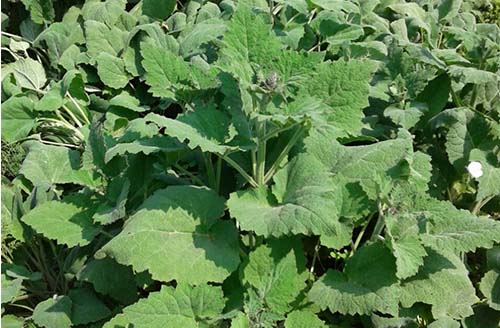CIM-Shreshta (CSIR-CIMAP)
Pogstemon cablin (Patchouli), also known as 'scent of the sixties' has a musky, earthy and exotic aroma. The essential oil of patchouli is obtained from the shade dried leaves of this plant and used for providing stability of the aroma of other essential oils used in the perfumery industry. The crop requires high humidity and moderate temperature ranging from 22-28°C. Climate of north-eastern states is ideal for its commercial cultivation where 3-4 cuttings can be easily obtained in a year. This multi-cut crop yields about 50-100 kgs of essential oil from one hectare (depending on the environment). The crop can be successfully integrated into orchards and plantations.
Patchouli crop can be grown up to an altitude of 900 to 1100 meters above msl (mean sea level). Usually, Patchouli plants prefer humid and warm climatic conditions. This crop thrives well on a heavy and evenly distributed annual rain fall ranging from 150-325 cm. In case of less rainfall areas, one can cultivate this crop under irrigated conditions. A temperature range of 22-28°C and humidity range 75-80% are suitable for its growth.
Patchouli can be cultivated in wide range of soils. However, a deep soil rich in organic matter with loose friable texture is ideal for plant growth. The optimum soil pH of 5.5 to 6.0 is ideal. Commercial crop growers should go for soil test to find out the fertility and based on results, soil should be supplemented with required nutrients and micro-nutrients.
land preparation of any crop plays major role in getting good yield. The soil should be brought to fine tilth stage by giving couple of deep ploughing followed by harrowing. The main field should be thoroughly disced and tilled so that soil can reach friable stage and any unwanted weeds can be destroyed. For enriching the soil fertility, it is better to add 15 to 20 tonnes of well-decomposed farm yard manure (FMY) like cow dung in the soil and this should be applied in the last ploughing. Suitable nematicide like asanit @ 150 kg/ha should be broadcasted and mixed well into the soil before (few days) transplanting the rooted cuttings in the field. The field should be made into ridges and furrows. The ridges should be 20-25 cm high and 18-21 cm broad with a spacing of 50 cm between the rows. Make sure to irrigate the beds a day before the transplanting the rooted cuttings. Rooted cuttings raised in nurseries should be transplanted in the field. The planting should be done at Old cutting 10-12 cm twig having 4-6 leaves and 3-4 nodes are best. Cutting should be prepared during in monsoon. 30-35 days old cuttings are best for transplanting in the month of July to September with spacing of 50x50 cm.
Patchouli crop responds very well to manures and fertilizers. A well-decomposed farm yard manure (FYM) of 10 to 15 tonnes or 7 ton vermi-compost per hectare should be applied along with the N:P:K ratio of 150:50:50 (N:P205:K2O perhectare) or 150:50:50 (N:P205:K2O per hectare cultivation) Nitrogen applied in 4 split doses.
Proper and timely irrigation in any crop ensures better produce and high yields. Generally, Patchouli crop is grown as rain-fed crop in hills. Don’t forget to irrigate the field immediate after transplanting. In Plains, it requires irrigation for every 3rd day during first 45 days. Subsequent irrigation should be given at 8 to 10 days interval
The first crop is ready for harvesting 4 to 5 months after transplanting and subsequent cuttings can be taken after every 3-4 months. The ideal time for harvesting the Patchouli leaves is when the leaves turn yellowish. Usually Patchouli crop can be maintained for 3 to 4 years. Make sure to harvest the leaves early morning hours or cool evening hours to avoid loss of essential oil. only green part ofthe growing shoots be harvested.
Yield depends on many factors like variety, soil, climate, type of propagation, age of the plant and other farm management practices. Under ideal conditions, fresh herbage yield of 150-200 q/ha and dry 30 q/ha; oil 2.0-2.5%, oil yield – 50-60 kg oil/ha.(The oil is found mainly in the leaf and small quantity may present in the tender parts of the stem)
Cost of cultivation : Rs. 50,000/ha/year
Gross return : Rs. 2,00,000-3,00,000/ha/year
Net profit : Rs. 1,50,000-2,50,000/ha/year


